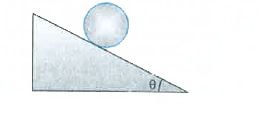Assertion : A wheel moving down a perfectly frictionless inclined plane will undergo slipping (not rolling motion)
Reason : For perfect rolling motion, work done Reason against friction is zero.
The correct Answer is:B
To solve the problem, we need to analyze both the assertion and the reason provided in the question.
1. Understanding the Assertion:
- The assertion states that a wheel moving down a perfectly frictionless inclined plane will undergo slipping and not rolling motion.
- On a frictionless surface, there is no frictional force to provide the necessary torque for rolling. Therefore, the wheel will not roll but will slip down the incline.
2. Understanding the Reason:
- The reason states that for perfect rolling motion, the work done against friction is zero.
- In perfect rolling motion, the point of contact between the wheel and the surface has zero relative velocity, which means that the wheel rolls without slipping. In this case, friction is necessary to prevent slipping and to allow for rolling.
3. Analyzing the Conditions:
- On a frictionless inclined plane, the coefficient of friction (μ) is zero. Thus, the frictional force is also zero.
- Since there is no friction, there is no torque generated about the center of the wheel, which means the wheel cannot roll and will instead slide down the incline.
4. Conclusion:
- The assertion is true: the wheel will slip down the incline due to the lack of friction.
- The reason is also true: in perfect rolling motion, the work done against friction is indeed zero. However, it does not explain why the wheel slips on a frictionless surface.
- Therefore, both the assertion and reason are true, but the reason does not adequately explain the assertion.
Final Answer:
Both assertion and reason are true, but the reason is not the correct explanation for the assertion.
- The assertion states that a wheel moving down a perfectly frictionless inclined plane will undergo slipping and not rolling motion.
- On a frictionless surface, there is no frictional force to provide the necessary torque for rolling. Therefore, the wheel will not roll but will slip down the incline.
- The reason states that for perfect rolling motion, the work done against friction is zero.
- In perfect rolling motion, the point of contact between the wheel and the surface has zero relative velocity, which means that the wheel rolls without slipping. In this case, friction is necessary to prevent slipping and to allow for rolling.
- On a frictionless inclined plane, the coefficient of friction (μ) is zero. Thus, the frictional force is also zero.
- Since there is no friction, there is no torque generated about the center of the wheel, which means the wheel cannot roll and will instead slide down the incline.
- The assertion is true: the wheel will slip down the incline due to the lack of friction.
- The reason is also true: in perfect rolling motion, the work done against friction is indeed zero. However, it does not explain why the wheel slips on a frictionless surface.
- Therefore, both the assertion and reason are true, but the reason does not adequately explain the assertion.
Both assertion and reason are true, but the reason is not the correct explanation for the assertion.
Topper's Solved these Questions
Similar Questions
Read each statement below carefully, and state, with reasons, if it is true or false : A wheel moving down a perfectly frictionless inclined plane will undergo slipping (not rolling) motion
View SolutionRead each statement below carefully and state with reasons, if it is true ot false. (a) During rolling the force of friction acts in the same direction as the direction of motion of c.m of the body. (b) The instantaneous speed of the point of contact during rolling is zero. (c ) The instantaneous acceleration of the point of contact during rolling is zero. (d) For perfect rolling motion, work done against friction is zero. (e) A wheel moving down a perfectly frictionless inclined plane will undergo slipping (not rolling motion).
View Solution
Knowledge Check
Statement-1 : A wheel moving down a perfectly frictionless inclined plane shall undergo slipping (not rolling).
Statement-2 : For rolling, torque is required, which is provided by tangential froce.AStatement-1 is true, Statement-2 is true ,
Statement-2 is correct explanation of Statement-1.BStatement-1 is true, Statement-2 is true but Statement-2 is not correct explanation of Statement-1.CStatement-1 is true, but statement-2 is false.DStatement-1 is false, but statement-2 is true.Which statement concerning a wheel undergoing rolling motion is true?
AThe angular acceleration of the wheel must be zero m/s2BThe tangential velocity is the same for all points on the wheel.CThe linear velocity for all points on the rim of the wheel is non-zero.DThere is no slipping at the point where the wheel touches the surface on which it is rolling.A : The work done by friction on an object during pure rolling motion is zero.
R : In pure rolling motion, there is relative motion at the point of contact.AIf both Assertion & Reason are true and the reason is the correct explanation of the assertion,BIf both Assertion & Reason are true but the reason is not the correct explanation of the assertion,CIf Assertion is true statement but Reason is false,DIf both Assertion and Reason are false statements,
Rolling Motion On Inclined Plane
View SolutionRolling Motion When Force Acts On A Body|Rolling Motion On Inclined Plane
View SolutionState whether the below given statement is true or false with proper reasoning. A Sphere moving down a perfectly smooth inclined plane will undergo slipping, not rolling motion
View SolutionA solid cylinder is rolling down the inclined plane without slipping. Which of the following isare correct?

View SolutionA sphere of moment of inertia 'I' and mass 'm' rolls down on an inclined plane without slipping its K.E. of rolling is
View Solution

